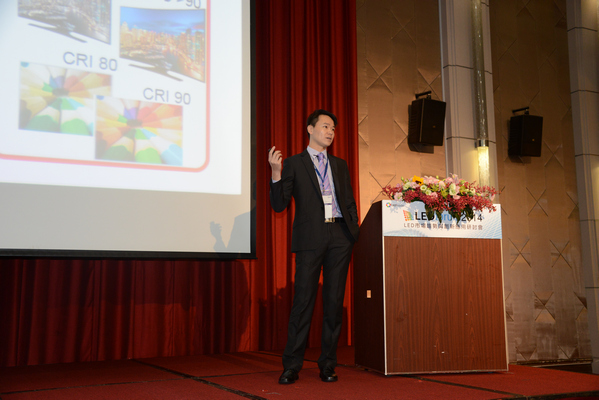The role of phosphor powder in LED applications is increasingly important to lower LED production costs and meet higher light quality demands, said Calvin Yeh, Global Strategic Marketing Manager, Lighting/PV Business Field, Merck Display Technologies, at LEDforum 2014 hosted by LEDinside on Oct. 24, 2014 in Taipei, Taiwan.
As observed at this year’s major lighting event Light + Building 2014 in Frankfurt, Germany, manufacturers have highlighted light quality, said Yeh. Light quality demands have increased from CRI 80 to CRI 90 in the past year, with some manufacturers even aiming for R9<0.
 |
|
Calvin Yeh, Global Strategic Marketing Manager, Lighting/PV Business Field, Merck Display Technologies speaking at LEDforum 2014 hosted by LEDinside in Taipei, Taiwan on Oct. 24, 2014. (LEDinside) |
Phosphor development in LED backlight market
In the backlight market, home theater systems have led to consumers preferences for larger TVs with higher resolutions, noted Yeh. Shipments of 4K2K UHD TV is increasing worldwide, especially in the Chinese market where there has been significant growth in market penetration. Higher resolution TVs in general will increase LED backlight manufacturers costs.
“Increases in TV resolutions usually drive down the overall luminous efficacy,” said Yeh. “In the past, LED manufacturers usually would solve this issue by adding LEDs, which would increase costs by nearly 50%.” But improvements in phosphor powder light conversion can raise LED brightness, reduce LED volume usage and bring down costs.
UHD TV backlight phosphor demands require narrower Full width at half maximum (FWHM). “In general, the color spectrum requirement for phosphors in backlight panel cell leans towards brown end of the spectrum…only a few types of phosphors can meet (higher) PPI demands,” said Yeh. Green and red phosphors also are required to achieve wider color gamut demands of NTSC greater than 90% in UHD TV, a technology development direction that phosphor manufacturers and LED chip package manufacturers are striving towards.
“There is usually a tradeoff between increasing phosphor powder’s color saturation and brightness,” said Yeh. “Usually the phosphor powder might meet color saturation demands but fall short in brightness.”
For instance, Merck’s Super Stable RGA phosphor combined s for high color gamut applications has a lower color space performance (NTSC 97%) when combined with market red phosphor compared to a market standard green made by Japanese manufacturer (NTSC 100%). Yet, in terms of brightness the same Super Stable RGA phosphor is brighter at 107% compared to the Japanese competitors 100%, an indicator Merck phosphor is more efficient, said Yeh.
 |
|
Calvin Yeh during his persentation at LEDforum 2014. |
Color performance demands in general lighting market
General lighting market’s price competitions are intensifying, and driving LED manufacturers to search for more cost effective solutions. “When LED bulbs were first launched on the market they cost US $20 each, but it has dropped to US $10,” said Yeh. “It might even drop to US $5. As some of you, who have visited China may have noted, LED bulbs are being sold at very low prices there.”
To compete, LED manufacturers need to effectively raise LED luminaires lumens per dollar, brightness, package and chip. “Raising CRI from 80 to 90, and increasing brightness is difficult for most manufacturers, but can be compensated with better phosphor material,” said Yeh. Similar to the backlight market, LED luminaire light quality demands are also growing. Manufacturers request different LED chips to have different brightness and colors, which is affected by chip material and the LED chip itself. The California Lighting Standard for instance requires CRI 90 with R9>50, said Yeh.
The company’s new Vivid Green (VGA) phosphor products aim to reach the California Lighting Standard. The product offers better brightness performance than conventional phosphor powders when combined with market red phosphors, offering 7% increase in brightness, while reducing phosphor powder usage by 10%, said Yeh.
Responding to Illuminating Engineering Society’s lobbying for the replacement of CRI with other color standards to better represent color, Yeh explained in general color measurements scale range from R1-R14, but the lighting industry tends to only address a specific range of R1-R9, while the remaining are left out. “Any changes in the color standards would have an impact the phosphor industry,” he said.
 |
|
Calvin Yeh smiles to reporters during press conference after his speech. |
Merck’s future plans
Merck is closely following red phosphor powder market developments. “Prices in the red phosphor powder market have plummeted,” said Yeh. “This is the only market where Chinese manufacturers have patent protection, and requires us to pay close attention to.”
Merck, which has been a phosohor supplier to Taiwanese LED packagers, is aiming to expand its product portfolio and business operations in Taiwan with the acquisition of special chemical and spectrometer manufacturer AZ Electronic Material earlier this year. “The company hopes it can provide more lighting material products to Taiwan’s upstream LED manufacturers, such as supplying spectrometers to LED wafer manufacturers and sapphire material supplies after the merge,” said Yeh. AZ Electronic Material has become an official Merck subsidiary.














